头颈部鳞癌放射治疗及靶向治疗进展-文档资料
- 格式:ppt
- 大小:760.01 KB
- 文档页数:67

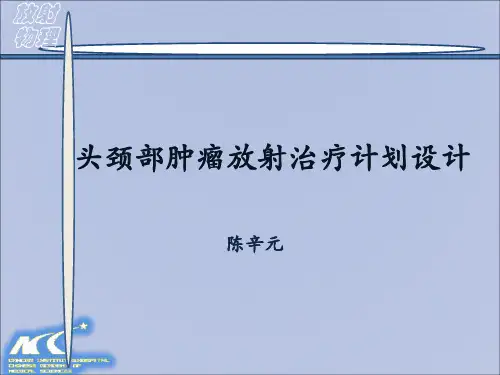
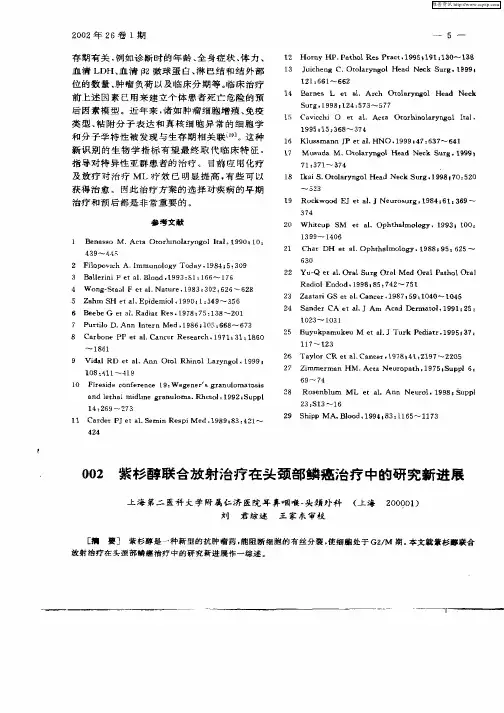



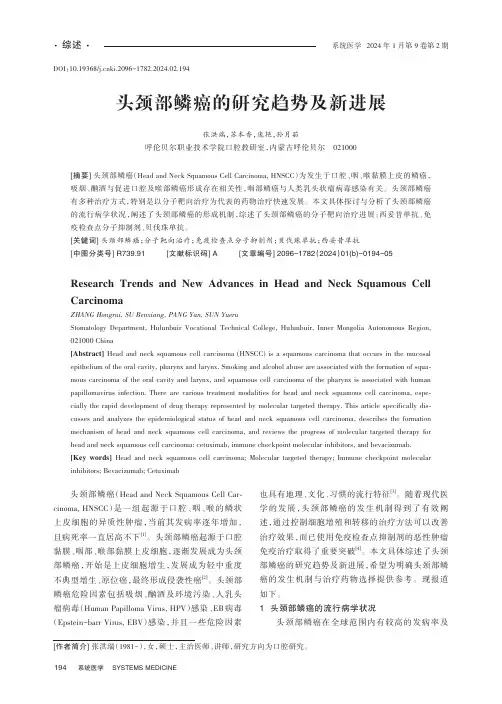
头颈部鳞癌的研究趋势及新进展张洪瑞,苏本香,庞艳,孙月茹呼伦贝尔职业技术学院口腔教研室,内蒙古呼伦贝尔021000[摘要]头颈部鳞癌(Head and Neck Squamous Cell Carcinoma, HNSCC)为发生于口腔、咽、喉黏膜上皮的鳞癌,吸烟、酗酒与促进口腔及喉部鳞癌形成存在相关性,咽部鳞癌与人类乳头状瘤病毒感染有关。
头颈部鳞癌有多种治疗方式,特别是以分子靶向治疗为代表的药物治疗快速发展。
本文具体探讨与分析了头颈部鳞癌的流行病学状况,阐述了头颈部鳞癌的形成机制,综述了头颈部鳞癌的分子靶向治疗进展:西妥昔单抗、免疫检查点分子抑制剂、贝伐珠单抗。
[关键词]头颈部鳞癌;分子靶向治疗;免疫检查点分子抑制剂;贝伐珠单抗;西妥昔单抗[中图分类号]R739.91 [文献标识码]A [文章编号]2096-1782(2024)01(b)-0194-05 Research Trends and New Advances in Head and Neck Squamous Cell CarcinomaZHANG Hongrui, SU Benxiang, PANG Yan, SUN YueruStomatology Department, Hulunbuir Vocational Technical College, Hulunbuir, Inner Mongolia Autonomous Region, 021000 China[Abstract] Head and neck squamous cell carcinoma (HNSCC) is a squamous carcinoma that occurs in the mucosal epithelium of the oral cavity, pharynx and larynx. Smoking and alcohol abuse are associated with the formation of squa‐mous carcinoma of the oral cavity and larynx, and squamous cell carcinoma of the pharynx is associated with human papillomavirus infection. There are various treatment modalities for head and neck squamous cell carcinoma, espe‐cially the rapid development of drug therapy represented by molecular targeted therapy. This article specifically dis‐cusses and analyzes the epidemiological status of head and neck squamous cell carcinoma, describes the formation mechanism of head and neck squamous cell carcinoma, and reviews the progress of molecular targeted therapy for head and neck squamous cell carcinoma: cetuximab, immune checkpoint molecular inhibitors, and bevacizumab. [Key words] Head and neck squamous cell carcinoma; Molecular targeted therapy; Immune checkpoint molecular inhibitors; Bevacizumab; Cetuximab头颈部鳞癌(Head and Neck Squamous Cell Car‐cinoma, HNSCC)是一组起源于口腔、咽、喉的鳞状上皮细胞的异质性肿瘤,当前其发病率逐年增加,且病死率一直居高不下[1]。
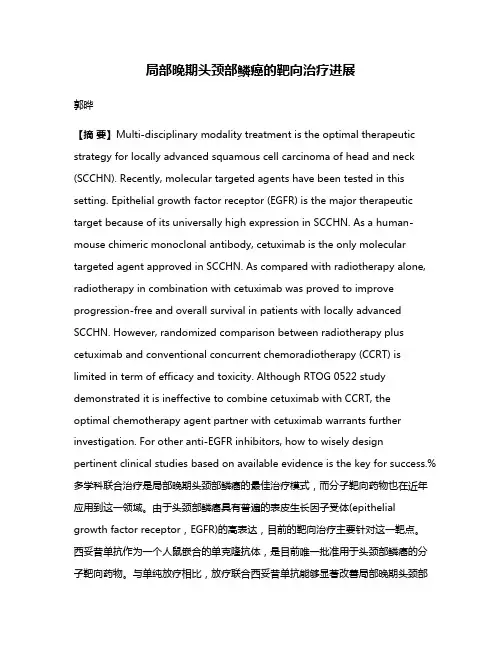
局部晚期头颈部鳞癌的靶向治疗进展郭晔【摘要】Multi-disciplinary modality treatment is the optimal therapeutic strategy for locally advanced squamous cell carcinoma of head and neck (SCCHN). Recently, molecular targeted agents have been tested in this setting. Epithelial growth factor receptor (EGFR) is the major therapeutic target because of its universally high expression in SCCHN. As a human-mouse chimeric monoclonal antibody, cetuximab is the only molecular targeted agent approved in SCCHN. As compared with radiotherapy alone, radiotherapy in combination with cetuximab was proved to improve progression-free and overall survival in patients with locally advanced SCCHN. However, randomized comparison between radiotherapy plus cetuximab and conventional concurrent chemoradiotherapy (CCRT) is limited in term of efficacy and toxicity. Although RTOG 0522 study demonstrated it is ineffective to combine cetuximab with CCRT, the optimal chemotherapy agent partner with cetuximab warrants further investigation. For other anti-EGFR inhibitors, how to wisely design pertinent clinical studies based on available evidence is the key for success.%多学科联合治疗是局部晚期头颈部鳞癌的最佳治疗模式,而分子靶向药物也在近年应用到这一领域。
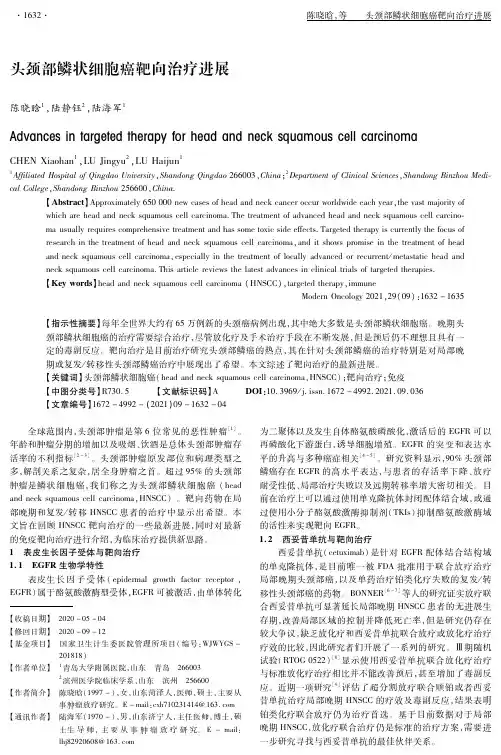
头颈部鳞状细胞癌靶向治疗进展陈晓晗1,陆静钰2,陆海军1AdvancesintargetedtherapyforheadandnecksquamouscellcarcinomaCHENXiaohan1,LUJingyu2,LUHaijun11AffiliatedHospitalofQingdaoUniversity,ShandongQingdao266003,China;2DepartmentofClinicalSciences,ShandongBinzhouMedi calCollege,ShandongBinzhou256600,China.【Abstract】Approximately650000newcasesofheadandneckcanceroccurworldwideeachyear,thevastmajorityofwhichareheadandnecksquamouscellcarcinoma.Thetreatmentofadvancedheadandnecksquamouscellcarcinomausuallyrequirescomprehensivetreatmentandhassometoxicsideeffects.Targetedtherapyiscurrentlythefocusofresearchinthetreatmentofheadandnecksquamouscellcarcinoma,anditshowspromiseinthetreatmentofheadandnecksquamouscellcarcinoma,especiallyinthetreatmentoflocallyadvancedorrecurrent/metastaticheadandnecksquamouscellcarcinoma.Thisarticlereviewsthelatestadvancesinclinicaltrialsoftargetedtherapies.【Keywords】headandnecksquamouscellcarcinoma(HNSCC),targetedtherapy,immuneModernOncology2021,29(09):1632-1635【指示性摘要】每年全世界大约有65万例新的头颈癌病例出现,其中绝大多数是头颈部鳞状细胞癌。
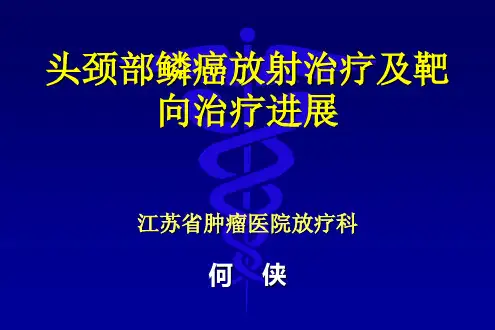
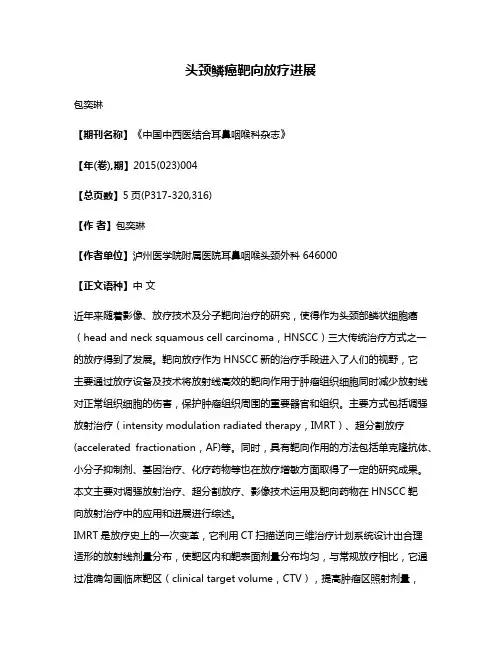
头颈鳞癌靶向放疗进展包奕琳【期刊名称】《中国中西医结合耳鼻咽喉科杂志》【年(卷),期】2015(023)004【总页数】5页(P317-320,316)【作者】包奕琳【作者单位】泸州医学院附属医院耳鼻咽喉头颈外科 646000【正文语种】中文近年来随着影像、放疗技术及分子靶向治疗的研究,使得作为头颈部鳞状细胞癌(head and neck squamous cell carcinoma,HNSCC)三大传统治疗方式之一的放疗得到了发展。
靶向放疗作为HNSCC新的治疗手段进入了人们的视野,它主要通过放疗设备及技术将放射线高效的靶向作用于肿瘤组织细胞同时减少放射线对正常组织细胞的伤害,保护肿瘤组织周围的重要器官和组织。
主要方式包括调强放射治疗(intensity modulation radiated therapy,IMRT)、超分割放疗(accelerated fractionation,AF)等。
同时,具有靶向作用的方法包括单克隆抗体、小分子抑制剂、基因治疗、化疗药物等也在放疗增敏方面取得了一定的研究成果。
本文主要对调强放射治疗、超分割放疗、影像技术运用及靶向药物在HNSCC靶向放射治疗中的应用和进展进行综述。
IMRT是放疗史上的一次变革,它利用CT扫描逆向三维治疗计划系统设计出合理适形的放射线剂量分布,使靶区内和靶表面剂量分布均匀,与常规放疗相比,它通过准确勾画临床靶区(clinical target volume,CTV),提高肿瘤区照射剂量,从而保护正常组织[1]。
Lee等[2]率先报道鼻咽癌(nasopharyngeal carcinoma,NPC)患者IMRT治疗结果,67例中晚期NPC患者IMRT治疗结束后2年,几乎所有患者的口干症状均未超过Ⅰ级;IMRT组和常规放疗组口干发生率分别为9.38%(2/32)和94.59%(35/ 37),张口困难发生率分别为6.25%(2/32)和72.97%(27/37),此研究显示NPC患者IMRT与常规放疗相比较在提高肿瘤局部控制率的同时明显降低了放疗不良反应。
头颈部肿瘤术中放射治疗及策略摘要:肿瘤是临床常见的一种恶性细胞之一,其在人类疾病中占据了很大一部分,放射治疗成为首选方法。
头颈部肿瘤属于常见的临床病症,在治疗过程中由于患者处于术后周身等原因,会对周围环境造成一定影响,而放射化疗作为一种最普遍也最有效的方法之一,但同时存在一些弊端,因此为保证治疗效果需要加强对其的研究探讨。
关键词:头颈部;肿瘤治疗;放射治疗1.引言头肿瘤是在临床上最常见的一种恶性疾病,严重危害到人类生命健康,而放射治疗对患者来说具有很大作用。
近十几年来随着国家医疗水平和经济条件不断改善提高以及人们生活质量逐渐提升,人们已经不再单纯追求生理需要而更加关注其安全性、有效性等方面。
在肿瘤手术中应用头颈部恶性肿瘤化疗作为辅助手段具有明显优势,但其安全性问题也成为国内外学者研究热点之一,基于此现状结合随访以及统计学等方法对其治疗效果进行研究分析。
2.研究背景头颈部肿瘤是临床上最常见的一种临床疾病,在现代社会中已经成为了普遍存在。
近年来,由于人类对放射治疗疗效及安全性认识不足,导致患者发生恶性手术造成死亡等情况已引起人们广泛关注和重视。
由于头颈部肿瘤患者年龄、生活经验等因素影响,机体免疫功能水平低,抵抗力差,易发生心内疾病。
目前临床上已确诊为癌症者,在治疗中主要采用对照组加盖式放射疗法及常规的颈外切除术配合方案来进行疗效评估,即先用无痛或减轻疼痛效果好的枕针将病人置于凉睡部位,再由患者身着半床后、双眼卧位并利用仰视片对其影像学检查,确认观察面是否清晰有皱折和凹陷位置[1]。
3.概况介绍在头颈部肿瘤手术中,放射治疗是最常用的放射疗法,患者术后出现全身麻醉和热敷等症状时可采取切开、按摩以及微波照射等方式进行医治。
临床表现主要有发热感与昏暗两种,其中以头颈上关节为首要部位的病人,由于年龄较大且身体较为发达而易发生呼吸困难,同时因为机体免疫功能低下容易引起淋巴结转移。
对头颈部肿瘤患者在放射治疗中的应用进行系统研究,并提出临床实践上可借鉴和参考的经验,目的是为完善相关理论提供基础资料,以提高病灶切除成功率与疗效等问题,同时也对肿瘤患者应用经济有效的放射治疗方案进行讨论和比较,从而提出合理化建议来指导临床实践。
[3]Rivette AS,Tokar EJ,Williams DE,et al.Selection of cell lines with enhanced invasive phenotype from xenografts of the human prostate cancer cell line WPE1-NB26[J].J Exp Ther Oncol,2005,5(2):111-123.[4]张彬,黄洪章,陶谦,等.人成釉细胞瘤裸鼠移植瘤的建立及其生物学特性研究[J].中国口腔颌面外科杂志,2004,2(4):270-273.[5]张磊涛,黄洪章,曾东林,等.人成釉细胞瘤裸鼠皮下移植瘤模型的建立[J].华西口腔医学杂志,2007,25(1):12-14.[6]黄洪章,张彬,陶谦,等.MMP-2抑制剂对成釉细胞瘤细胞体外侵袭的影响[J].中国口腔颌面外科杂志,2004,2(4):266-269.[7]Nakoman C.Effects of basic fibroblast factor (bFGF)on MMP-2,TIMP -2,and type -I collagen levels in human lung carcinoma fibroblasts[J].Biochimie,2005,87(3):343-351.[8]Giannelli G,Bergamini C,Marinosci F,et al.Clinical role ofMMP-2/TIMP-2imbalance in hepatocellular carcinoma [J].Int J Cancer ,2002,97(4):425-431.[9]Lizarraga F,Maldonado V,Melendez-Zajgla J.Tissue inhibitor of metalloproteinases -2growth -stimulatory activity is mediated by nuclear factor -kappa B in A549lung epithelial cells [J].Int J Biochem Cell Biol,2004,36(8):1655-1663.[10]Ryo A,Uemura H,Ishiguro H,et al.Stable suppression oftumorigenicity by Pin1-targeted RNA interference in prostatecancer[J].Clin Cancer Res,2005,11(20):7523-7531.[11]Howard BA,Furumai R,Campa MJ,et al.Stable RNA interfer -ence-mediated suppression of cyclophilin A diminishes non -small-cell lung tumor growth in vivo [J].Cancer Res,2005,65(19):8853-8860.[12]Piva R,Chiarle R,Manazza AD,et al.Ablation of oncogenic ALKis a viable therapeutic approach for anaplastic large -cell lymphomas[J].Blood,2006,107(2):689-697.[13]Chan DW,Ng IO.Knock -down of hepatitis B virus X proteinreduces the tumorigenicity of hepatocellular carcinoma cells [J].J Pathol,2006,208(3):372-380.[14]Moyano JV,Evans JR,Chen F,et al.Alpha B-crystallin is a noveloncoprotein that predicts poor clinical outcome in breast cancer[J].J Clin Invest,2006,116(1):30-32.[14]Wyatt CA,Geoghegan JC,Brinckerhoff CE.Short hairpin RNA-mediated inhibition of matrix metalloproteinase -1in MDA -231cells:effects on matrix destruction and tumor growth [J].Cancer Res,2005,65(23):11101-11108[15]Bhakta S,Hong P,Koc O.The surface adhesion molecule CXCR4stimulates mesenchymal stem cell migration to stromal cell -derived factor -1in vitro but does not decrease apoptosis under serum deprivation[J].Cardiovasc Revasc Med,2006,7(1):19-24.4头颈癌放疗、化疗及靶向治疗新进展Radiotherapy,chemotherapy and target therapyfor treatment of head and neck cancer:new developments [Article in German].Knecht R.HNO,2009,57(5):436-445.约60%的上消化道恶性肿瘤患者属于临床Ⅲ-Ⅳ期,多种模式的治疗策略使患者生存率提高至50%。